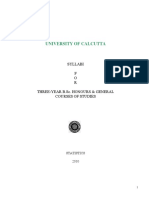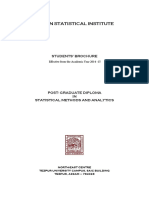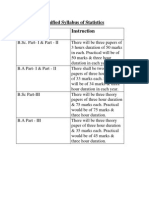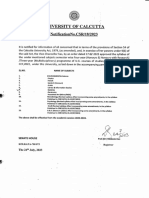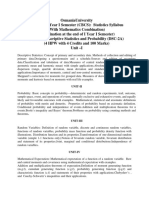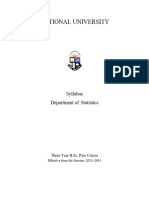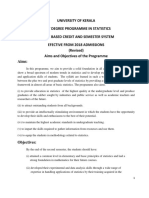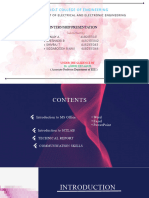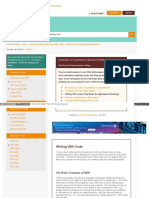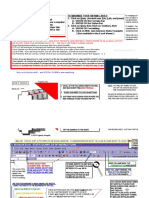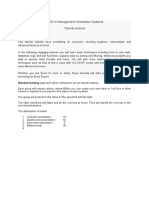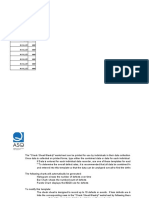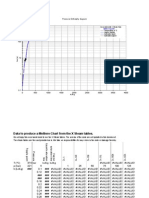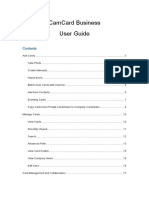STATISTICS
UNDER-GRADUATE SYLLABUS
B.A./B.Sc. Part I EFFECTIVE FROM 2014 EXAMINATIONS
Paper I: Probability Theory
Unit I: Random Experiment and Probability Measure
Random experiments, sample space, events, algebra of events, axiomatic definition of
probability, probability spaces, relationship of axiomatic and classical probability, role of
frequency ratios, properties of probability measure, subadditivity, Boole’s inequality,
probability of union of events, matching problem, repeated birthday problem, occupancy
problem, statistics of physical particles, conditional probability and associated probability
space, Bayes theorem, independence of events.
Unit II: Random Variable and Random Vector
Random variables as functions, induced probability measure via inverse mapping, induced
probability distribution, distribution functions, distribution functions and their properties,
probability mass function (pmf) of discrete random variables, probability density function
(pdf) of continuous random variables,
Random vector, marginal and conditional distributions, independence of random variables
Unit III: Mathematical Expectation and Functions of Random Variables
Mathematical expectation, moments, factorial moments, moment generating function,
probability generating function, Expectation of jointly distributed random variables, marginal
and conditional expectation, correlation, Chebyshev’s inequality, Markov’s inequality,
functions of random variables.
Unit IV: Statistical Distributions
Bernoulli distribution, binomial distribution, Poisson distribution, derivation of Poisson
distribution as a limiting case of binomial distribution, geometric distribution, negative
binomial distribution, hypergeometric distribution, multinomial distribution, uniform
distribution, normal distribution and its relationship with the binomial and Poisson
distribution, Cauchy distribution, bivariate normal distribution and its marginal and
conditional distributions.
Book recommended:
1. Beumont, G.P.: Probability and random variables.
2. Meyer, Paul L. (1970): Introductory probability and statistical applications, Addision
Wesley.
�3. Mukhopadhyay, P. (1996): Theory of Probability, New Central Book Agency, Calcutta.
4. Parzen, E. (1960): Probability theory and its applications, Wiley Eastern.
Paper II: Statistical Methods and Computer applications
Unit I: Computer Applications
Origin of computers; Computer generations; Importance of computers; Hardware
components: CPU, Memory, Input output devices. Mouse-navigation tool. Operating
system: History, Windows operating system-Interface; File management; Input output
services.
Software: Introduction to System software; Application software: Word processing software
– Microsoft Office Word 2007, Spread sheet software – Microsoft Office Excel 2007,
Presentation software – Microsoft Office PowerPoint 2007 (Interface of all the three
application software, File handling, Editing, Formatting, and final output)
Excel as a database software: Cell referencing, Concept of list, Manipulation of data, Data
sorting and filtering, Naming of cells, Functions specifically Numeric/Mathematical
functions, Statistical functions, Logical functions, and Lookup functions; Statistical analysis
using Excel – Descriptive statistics, Curve fitting, Correlation, and Regression analysis; Excel
graphs.
Basics of internet and its application in communication.
R - Statistical package: Basics of R, R Studio and R commander; Creation of data files;
Import export of data files; Transformation of data; Graphical representation of data using
R; Descriptive statistics using R.
Unit II: Visualization of data and descriptive statistics
Concept of Statistical population and sample, classification of data, quantitative and
qualitative data, ordinal and nominal data, time series and cross sectional data, multivariate
data.
Construction of tables with one or more factors of classification, Diagrammatic and
graphical representation of grouped data. Frequency distributions, cumulative frequency
distributions and their graphical representation, histogram, frequency polygon and ogives,
Stem and leaf chart. Box plot, scatter plot for bivariate data, trellis plot for multi-variable
data.
Measures of central tendency, dispersion, moments, skewness and kurtosis.
2
� Unit III: Correlation and Regression for Bivariate Data
Simple linear regression, method of least squares, correlation coefficient, correlation ratio,
intraclass correlation, rank correlation, fitting of some nonlinear curves.
Unit IV: Multivariate Data and analysis of categorical data
Multivariate data: Multiple regression, multiple and partial correlation for three variables.
Analysis of Categorical Data: consistency, independence and association of attributes,
coefficient of contigency.
Books recommended:
1. Freund J.E (2001): Mathematical Statistics, Prentice Hall of India.
2. Goon, A.M., M.K. Gupta and B. Dasgupta (1991): Fundamentals of statistics, vol I,
World Press, Calcutta.
3. Goon, A.M., M.K. Gupta and B. Dasgupta (1991): Fundamentals of statistics, vol, II,
World Press, Calcutta.
4. Weatherburn C.E. (1961): A first course of Mathematical statistics, Cambridge University
press.
5. Sinha, P.K. (2010): Computer fundamentals, University Science press.
6. Rajaraman, V. (2010): Fundamentals of computers, PHI.
7. White, R. (1999): How computers work.
Practical
Numerical problems and solutions based on theory papers I and II.





